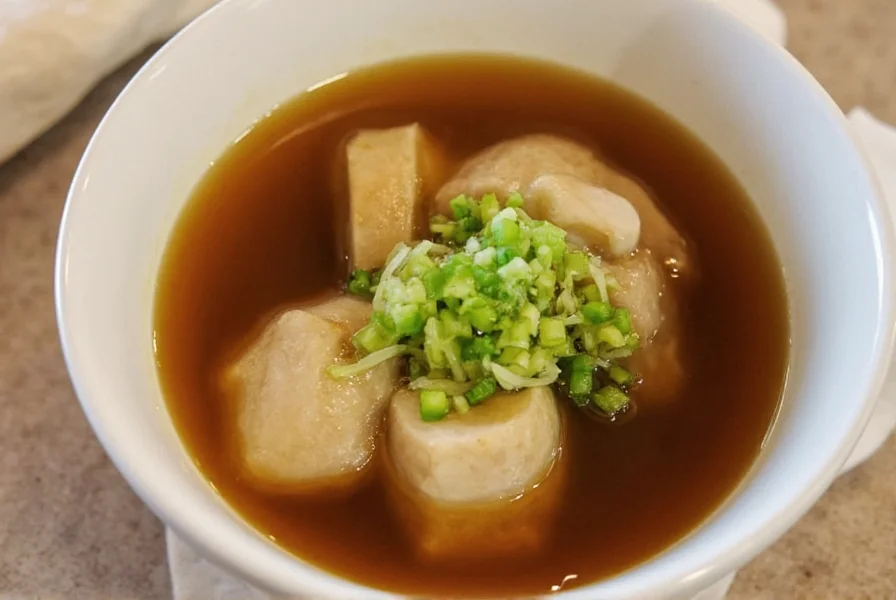Understanding Miso Ginger Broth: More Than Just Soup
Miso ginger broth represents a cornerstone of Japanese culinary tradition, blending ancient fermentation techniques with simple, nourishing ingredients. This broth differs significantly from Western-style stocks—it's not simmered for hours but rather assembled at lower temperatures to maintain the living enzymes in miso paste. The magic happens when high-quality white miso (shiro miso) meets freshly grated ginger in a delicate dance of umami and warmth.
Traditional preparation begins with a clean dashi base—typically kombu (kelp) steeped in water just below boiling point. Adding miso paste directly to boiling liquid destroys its beneficial bacteria and alters the flavor profile. The ginger component should be fresh, not powdered, to deliver that bright, spicy note without bitterness. This attention to detail separates authentic miso ginger broth from the instant packets commonly found in supermarkets.
Nutritional Profile and Evidence-Based Benefits
While not a medical treatment, miso ginger broth offers nutritional components supported by research. A standard cup (240ml) contains approximately:
| Nutrient | Amount per Serving | Key Benefits |
|---|---|---|
| Protein | 3-4g | From fermented soybeans |
| Probiotics | Varies by miso type | Supports gut microbiome diversity |
| Gingerols | Naturally occurring | Anti-inflammatory compounds |
| Sodium | 500-800mg | Lower than commercial broths |
Studies published in Frontiers in Microbiology confirm that unpasteurized miso contains live cultures that may support digestive health. Research in the Journal of Medicinal Food notes ginger's potential role in supporting healthy inflammation response. The broth's nutritional value depends entirely on preparation method—boiling destroys probiotics, while proper technique preserves them.
Authentic Preparation Method
Creating genuine miso ginger broth requires respecting the ingredients' nature. Here's the traditional approach that preserves both flavor and nutritional integrity:
Essential Ingredients
- 4 cups (950ml) kombu dashi (soaked kombu in water, not boiled)
- 3-4 tablespoons white miso paste (avoid red or barley miso for delicate flavor)
- 1.5 tablespoons freshly grated ginger (young ginger preferred)
- 1 green onion, thinly sliced (optional)
Step-by-Step Preparation
- Prepare dashi by soaking a 4-inch kombu piece in cold water for 1-2 hours, then gently warming to 160°F (71°C) without boiling
- Remove kombu and maintain liquid temperature below 165°F (74°C)
- Mix miso paste with 1/2 cup of warm dashi in a separate bowl until smooth
- Grate fresh ginger using a fine microplane for maximum flavor release
- Gently incorporate miso mixture and ginger into main dashi
- Heat to 150°F (65°C) maximum—never boil after adding miso
- Serve immediately or cool for storage
This gentle miso ginger broth preparation technique preserves the enzymatic activity destroyed by high heat. Commercial versions often skip the proper dashi base, using MSG or artificial flavors instead of natural umami sources. For vegan miso ginger broth, ensure your dashi uses only plant-based ingredients—traditional dashi sometimes includes bonito flakes.
Culinary Applications Beyond Soup
Miso ginger broth's versatility extends far beyond traditional soup. Chefs worldwide utilize it as:
- Sauce foundation: Reduce by half for glazes on fish or vegetables
- Grain cooker: Substitute water when preparing rice or quinoa
- Marinade base: Combine with citrus for tenderizing proteins
- Stir-fry liquid: Replace oil for healthier vegetable preparations
- Detoxifying morning drink: Warm broth with lemon juice
When incorporating into dishes, add miso ginger broth toward the end of cooking to preserve its delicate flavor profile. For quick miso ginger broth applications in weeknight cooking, keep frozen portions ready to enhance simple meals.
Storage and Preservation Techniques
Proper storage maintains both flavor and nutritional value:
- Refrigeration: Store in airtight container for up to 5 days
- Freezing: Portion into ice cube trays, then transfer to freezer bags (keeps 3 months)
- Never refreeze: Once thawed, use within 2 days
- Reheating: Warm gently without boiling to preserve probiotics
When making large batch miso ginger broth, prepare the dashi base separately from the miso mixture. Combine only when ready to serve to maximize shelf life. The ginger flavor intensifies over time, so adjust initial quantities accordingly.
Troubleshooting Common Preparation Issues
Even experienced cooks encounter challenges with this delicate broth:
- Too salty: Dilute with additional dashi or add a small potato slice while warming (remove before serving)
- Bitter aftertaste: Caused by boiling—always maintain temperature below 165°F
- Cloudy appearance: Normal with fresh ginger; strain through cheesecloth if preferred clear broth
- Weak flavor: Increase miso proportion or use a more mature miso variety
For those seeking low sodium miso ginger broth, select white miso labeled "reduced sodium" and increase ginger proportion to compensate for flavor depth.
Frequently Asked Questions
Can I use dried ginger instead of fresh in miso ginger broth?
While fresh ginger provides superior flavor and active compounds, dried ginger can substitute in a pinch. Use 1 teaspoon dried ginger powder per tablespoon of fresh, but expect less vibrant flavor and reduced gingerol content. Fresh ginger's enzymatic properties contribute significantly to the broth's digestive benefits.
Does miso ginger broth contain alcohol?
Traditional miso paste fermentation produces minimal alcohol (typically under 1%), similar to ripe fruit. The amount in a standard serving of miso ginger broth is negligible—less than 0.05%—making it suitable for most dietary restrictions. Commercial versions may vary, so check labels if avoiding all alcohol.
How long do probiotics survive in prepared miso ginger broth?
When prepared correctly (never boiled), live cultures remain active for up to 5 days refrigerated. Studies show a gradual decline: approximately 80% viability on day 1, 60% by day 3, and 30% by day 5. Freezing preserves probiotics longer but reduces viability upon thawing.
Can miso ginger broth help with digestion?
Research indicates components in miso ginger broth may support digestive health. The probiotics in unpasteurized miso contribute to gut microbiome diversity, while gingerols in fresh ginger have demonstrated effects on gastric motility. However, it's not a treatment for digestive disorders—rather a potentially supportive element in a balanced diet.











 浙公网安备
33010002000092号
浙公网安备
33010002000092号 浙B2-20120091-4
浙B2-20120091-4